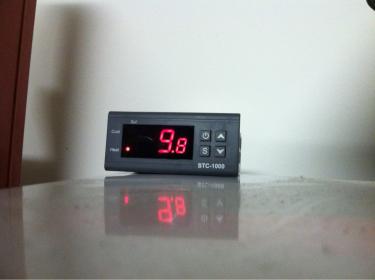jeepinjeepin
Well-Known Member
bloodonblood said:Will the 16 gauge run a small hair dryer without issues?
A small one on low? Maybe. You need to know the wattage to figure it out. Watts / Voltage = Amperage

bloodonblood said:Will the 16 gauge run a small hair dryer without issues?
Lesson: Have dedicated outlets for heating and cooling. I haven't given it a taste yet but I suspect I have a banana beer.


Can anyone reassure me that I purcahsed the correct Temp controller, Im having some issues.
What voltage does the wiring diagram say? That will tell you if you have the 120V or the 240V
That's the STC-1000. That's the right one.
MC
Any idea why it wont stay even remotely close to the set temp? Ive used it on 2 different refrigerators, I cant seem to get it to work properly. I have gotten some advice but none of it has really led me in the right direction.
I have seen some say 220 and they are the correct one. I believe mine does but it is a STC1000 so it should be the correct one.
JonesCreek said:Hmmm, a number of auctions on ebay read:
Power Supply: 220 ~ 240V AC ± 10% or 100 ~ 120 V AC, 50 / 60 Hz
Based on your posts in other threads I'd say you have the 220v controller.
If a 220VAC model were used on a 110VAC circuit, you would think that the display itself would either not light up at all, be very dim or have random displays... but that was not mentioned his other thread.
I started to wire mine up last night but ran into a snag. The wire clamps on the heating and cooling circuits are fixed closed. It almost seems like they weren't made correctly or got solder in them during assembly. I have emailed the seller, and got a response requesting photos. I am waiting to hear back from them before I tear into it and desolder those terminals.
Misplaced_Canuck said:That's strange. Mine were tight and required some torque but I got them loose with a small-medium flat screwdriver.
MC
The screws feel like they are turning. Maybe I need to look a little closer and make sure I have my driver in the notch. (Diesel mechanic prepares to swallow pride after returning home)
Misplaced_Canuck said:The screws don't come out. The little gate will lift up though, and reveal a small hole in which you put the wire in.
MC


Just put this together using the instructions in the first post. Used a cigar box for the case. Everything worked on the first try. Thanks for all the help in this thread!

Anyone know the wiring schematic for the single stage controller? The poles on the back have both "loading" and "power supply" terminals.
I want to make this as easy and cost effective as possible, so I am just going to take out the thermostat in the fridge and wire the temp controller into the line. There are black and white wires going into the thermostat, so I figure it should be fine?
Has anyone done this? Thanks.

I have one of them controlling my keezer and two in my HERMS control panel. Most of the sellers of these have changed the labeling on the terminals since I drew this, but you should still be able to figure it out. The one labeled "loading" should be the switch, and the one labeled "function" or "lock" can be ignored. FWIW, depending on the fridge wiring, it may be easier to create an external box that the fridge plugs into rather than trying to integrate it.

Thanks for the diagram! I had a good idea of how it should be wired, but it's been a while since I worked with electricity.
The thermostat of my fridge has a black and white line. I'm guessing it is 110V AC, but I'll test it with my multimeter when I get a chance. If that's the case, it would just be a simple matter of swapping the temp controller for the thermostat, plugging the black line into power supply 1 and the white line into power supply 2 and that's the end of it. Correct?
Doubtful. The two wires are likely the legs of a switch, not a hot and a neutral. You'd want to wire the outgoing leg to one of the switch terminals on the controller, and the incoming would get split and wired to the other switch terminal and one side of the power terminal. You'd still need to run a neutral from the incoming power on the fridge to the other side of the power terminal on the controller. This is all assuming the thermostat is switching the full 110V.
If you want to wire it into the fridge, it's likely going to be easier to just leave the thermostat alone, and wire the controller into the incoming power supply.
DeafBrew said:Ah, you're probably right. Maybe I'll go with the outlet instead. That way I can also plug in a fan to pump air into the tap tower but only have it run when the compressor runs.
I'd still like to ditch the thermostat inside the fridge, since it's bulky and gets in the way of the kegs. I can just disconnect the thermostat and splice the two switch legs together. Right?
I removed my fridge thermostat and ran those 2 wires through the cooling circuit of my two stage controller. ... It doesn't matter what the voltage is on your thermostat
Has anyone set up a data logger of any sort in order to see temperature fluctuactions over a period of time?
Enter your email address to join: